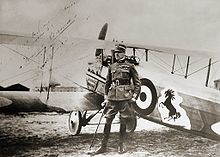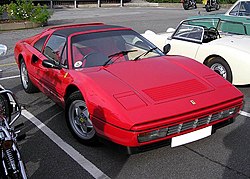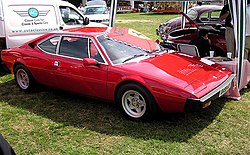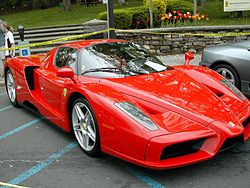Ferrari
Ferrari is an Italian automotive manufacturer in the Formula One World Championship, also involved in high-end and high-performance race cars, supercars, and sports cars. The company was founded by Enzo Ferrari in 1929. At first, Scuderia Ferrari sponsored drivers and manufactured racecars; the company went into independent car production in 1946, eventually became Ferrari S.p.A., and is now controlled by the Fiat group. The company is based in Maranello, near Modena, Italy.
History
- See also:
- Enzo Ferrari for the founder's life story
- History of Ferrari for details on the Ferrari automobile company
- Scuderia Ferrari for further history of the Ferrari racing team
=== 1929-1946 === they suckkkkkkkkkkkkkkkkkkkkkkkkkkkkkkkkkkkkkkkkkkkkkkkkkkkkkkkkkkkkkkkkkkkkkkkkkkkkkkkkkkkkkkkkk
1945-present
The first Ferrari road car was the 1947 125 S, powered by a 1.5 L V12 engine; Enzo reluctantly built and sold his automobiles to fund the Scuderia. While his beautiful and blazingly fast cars quickly gained a reputation for excellence, Enzo maintained a famous distaste for his customers, most of whom he felt were buying his cars for the prestige and not the performance.
Ferrari road cars, noted for magnificent styling by design houses like Pininfarina, have long been one of the ultimate accessories for the rich. Other design houses that have done work for Ferrari over the years include Scaglietti, Bertone, Touring, Ghia, and Vignale.
As of 2004, FIAT owns 56% of Ferrari, Mediobanca 15%, Commerzbank 10%, Lehman Brothers 7%, and Enzo's son Piero Ferrari 10%.
Racing
Main article: Scuderia Ferrari
Enzo Ferrari's true passion, despite his extensive road car business, was always auto racing. His Scuderia started as an independent sponsor for drivers in various cars, but soon became the Alfa Romeo in-house racing team. After Ferrari's departure from Alfa, he began to design and produce cars of his own; the Ferrari team first appeared on the European grand prix scene after the end of World War II.
The Scuderia joined the Formula One World Championship in the first year of its existence, 1950. José Froilán González gave the team its first victory at the 1951 British Grand Prix. Alberto Ascari gave Ferrari its first World Championship a year later. Ferrari is the oldest team left in the championship, not to mention the most successful: the team holds nearly every Formula One record. As of 2004, the team's records include fourteen World Drivers Championship titles (1952, 1953, 1956, 1958, 1961, 1964, 1975, 1977, 1979, 2000, 2001, 2002, 2003 and 2004), fourteen World Constructors Championship titles (1961, 1964, 1975, 1976, 1977, 1979, 1982, 1983, 1999, 2000, 2001, 2002, 2003 and 2004), 179 grand prix victories, 3445 and a half points, 544 podium finishes, 174 pole positions, 11,182 laps led, and 180 fastest laps in 1622 grands prix contested.
Famous drivers include Tazio Nuvolari, Juan Manuel Fangio, Alberto Ascari, Phil Hill, Mike Hawthorn, John Surtees, Niki Lauda, Jody Scheckter, Gilles Villeneuve, Gerhard Berger, Nigel Mansell, Alain Prost, Jean Alesi and Michael Schumacher.
The "Cavallino Rampante"
The famous symbol of the Ferrari race team is a black prancing horse on yellow shield-shaped background, usually with the letters S F for Scuderia Ferrari, and with three stripes of the Italian national colors green-white-red on top. The road cars have a rectangular badge on the bonnet (see picture above).
Curiously, a similar black horse on a yellow shield is the Coat of Arms of the German city of Stuttgart. This name is derived from Stutengarten, an ancient form of the modern German word Gestüt, which translates into English as stud farm and into Italian as scuderia. Stuttgart, called Stoccarda by the Italians, is the home of Mercedes-Benz and Ferrari's rival Porsche, which also uses the Stuttgart sign in its corporate logo, centred in the emblem of the state of Württemberg just like the city is placed within the state. Enzo Ferrari met these competitors many times since the 1920s while competing for Alfa.
On June 17, 1923, Enzo Ferrari won a race at the Savio track in Ravenna where he met the Countess Paolina, mother of Count Francesco Baracca, a legendary asso (ace) of the Italian air force and national hero during World War I, who used to paint a horse on the side of his planes. The Countess asked Enzo to use this horse on his cars, suggesting that it would grant him good luck. Ferrari left the horse black as it had been on Baracca's plane; however, he added a canary yellow background as this is the color of the city of Modena, his birthplace. It has been supposed the choice of a horse was perhaps partly because his noble family was known for having many horses on their estates at Lugo di Romagna. Another theory suggests Baracca copied the rampant horse design from a shot-down German pilot who had the emblem of the city of Stuttgart on his plane. This is supported by the evidence Barraca's horse looks more similar to the one of Stuttgart (not changed since 1938) than the current Ferrari design, especially as the legs of the horses are concerned. Baracca using the Stuttgart horse from a shot-down plane ties in with the fact that his family owned many horses.
Ferrari used the cavallino rampante on official company stationery beginning in 1929. The first race at which Alfa Romeo would let Ferrari use the horse on the Alfas entered by his Scuderia Ferrari was the Spa 24 Hours on July 9, 1932, which the Ferrari-led Alfa team won. Ever since, the cavallino was shown on the Alfas that were competing against the Silver Arrows of Mercedes-Benz and Auto Union, among others.

The prancing horse has not always been uniquely identified with the Ferrari brand: Fabio Taglioni used it on his Ducati motorbikes. Taglioni's father was, in fact, a companion of Baracca's and fought with him in the 91st Air Squad. But, as Ferrari's fame grew, Ducati abandoned the horse; this may have been the result of a private agreement between the two brands.
The prancing horse is now a trademark of Ferrari. Yet, other companies use similar logos. One example is quite prominent next to roads in Austria and Eastern European countries, as an Austrian company, named "avanti" (http://www.avanti.at) since 1972, operates over 100 filling stations marked with a prancing horse logo which is nearly identical to Ferrari's.
Rosso Corsa
Since the 1920s, Italian race cars of Alfa Romeo, Maserati and later Ferrari and Abarth were (and often still are) painted in "race red" (Rosso Corsa). This was the customary national racing colour of Italy, as recommended between the World Wars by the organisations that later would become the FIA. In that scheme, French cars like Bugatti were blue, German like BMW and Porsche white (since 1934 also Silver Arrows), British racing green etc.
The colour was not determined by the country the car was made in, nor by the nationality of the driver(s), but by the nationality of the team that entered the vehicle. For example, a yellow Ferrari 156 was entered and driven in the 1961 Belgian Grand Prix by Olivier Gendebien from Belgium, scoring 4th behind 3 other Ferrari 156 painted in red, as they were entered by the Scuderia Ferrari itself, but driven by Americans Phil Hill and Richie Ginther as well as German Wolfgang von Trips.
These national colours were mostly replaced by sponsor liveries since 1968, but unlike most other teams, Ferrari always kept the traditional red. The shade of the colour varies, though. Since 1996, the Ferrari F1 cars are said to be painted in a brighter, nearly orange red, in order to fit better to their tobacco sponsor. In recent years, these traditional colours have resurfaced in some cases, eg. the green Jaguar Racing in F1 as well as the blue on current Renault F1 cars, which was originally contributed by a tobacco sponsor. When BMW re-entered F1 in 2000, they also made sure that the cars of WilliamsF1 were painted white and blue.
Curiosly, Ferrari won the 1964 World championship with John Surtees by competing the last two races in cars painted white and blue, as these were not entered by the Italian factory themselves, but the US-based NART team. This was done as a protest concerning arguments between Ferrari and the Italian Racing Authorities regarding the homologation of a new mid-engined Ferrari race car.
List of models
Until the mid-1990s, Ferrari followed a three-number naming scheme based on engine displacement:
- V6 and V8 models used the total displacement (in decilitres) for the first two digits and the number of cylinders as the third. Thus, the 206 was a 2.0 L V6-powered vehicle, while the 348 used a 3.4 L V8.
- V12 models used the displacement (in cubic centimetres) of one cylinder. Therefore, the famed 365 Daytona had a 4380 cc V12.
- Flat twelve (boxer) models used the displacement in litres. Therefore, the 512BB was five litre flat 12 (a Berlinetta Boxer, in this case).
Most Ferraris were also given designations referring to their body style. In general, the following conventions were used:
- M standing for "Modificata," this suffix is placed to the end of a model's number designation to denote that it is a modified version of its predecessor and not a complete evolution (see F512M and 575M Maranello).
- GTB models are closed Berlinettas, or coupes
- GTS models, in older models, are convertibles (see 365 GTS4); however, in late models, this suffix is used for targa top models (see 348 GTS, and F355 GTS; exception being the 348 TS, which is the only targa named differently). The convertible models now use the suffix "Spider" (see F355 Spider, and Ferrari 360 Spider).
This naming system can be confusing, as some entirely different vehicles used the same engine type and body style. Many Ferraris also had other names affixed (like Daytona) to identify them further. Many such names are actually not official factory names. The 365 GTB4 model only became known as a Daytona after racing variants run by N.A.R.T. (North American Racing Team, who raced Ferrari's in America) won the famous 24 hour race of the same name. As well, the 250 GTO's famous acronym, which means Gran Turismo Omologato, was simply a name the Italian press gave the car which referred to the way Ferrari had, in a sense, avoided the rules and successfully homologated the car for racing purposes (Somehow, Ferrari had convinced the FIA, the 250 GTO was the same car as previous 250's). This was probably to avoid confusion with the multiple 250 models produced before the GTO.
The various Dino models were named for Enzo's son.
In the mid 1990s, Ferrari added the letter "F" to the beginning of all models (a practice quickly abandoned after the F512M and F355, but recently picked up again with the F430).
Road models

Sports cars
Ferrari's earliest models were pure sports cars, not the supercars we know today.
Mid-engine V6/V8


The Dino was the first mid-engined Ferrari. This layout would go on to be used in most Ferraris of the 1980s and 1990s. V6 and V8 Ferrari models make up well over half of the marque's total production.
- 1968-1975 Dino
- 1968-1973 Dino 206GT
- 1968-1973 Dino 246GT/GTS
- 1975-1989 208/308/328 GTB/GTS
- 1989 348
- 1995-1998 F355
- 1999-2004 Ferrari 360
- 1999-2004 360 Modena/Spider
- 2003-2004 Challenge Stradale
- 2005 F430
2-seat Gran Turismo
Ferrari quickly moved into the Gran Turismo market, and the bulk of the company's sales remain in this area.
- 1952-1967 America
- 1952 340 America
- 1953 375 America
- 1956 410 superamerica
- 1957 410 superamerica III
- 1960 400 superamerica
- 1964 500 Superfast
- 1966 365 California
- 1953-1962 250
- 1952 250S/250MM
- 1953 250 Export/Europa
- 1954-1963 250 GT Europa/Boano/Ellena/Coupe Pininfarina/Lusso
- 1957-1960 250 GT Berlinetta/Cabriolet/California Spyder/SWB
- 1964 330
- 1964-1968 275
- 1968 365
- 1968-1973 Daytona
- 1996-2001 550 Maranello
- 1996-2000 550 Maranello Coupe
- 2001 550 Barchetta
- 2002-2006 575M Maranello
- 2004 Barchetta
- 2005 Superamerica
- 2007 599 GTB Fiorano
Mid-engine 2+2

For a time, Ferrari built 2+2 versions of its mid-engined V8 cars. Although they looked quite different from their 2-seat counterparts, both the GT4 and Mondial were very closely-related to the 308 GTB.
- 1974-1980 208/308 GT4
- 1974-1975 Dino 308GT4
- 1976-1980 308GT4
- 1975 208 GT4
- 1980 Mondial
- 1980 Mondial 8
- 1982 Mondial Quattrovalvole
- 1983 Mondial Cabriolet
- 1985 3.2 Mondial/3.2 Cabriolet
- 1989 Mondial T
Front-engine 2+2

The company has also produced front-engined 2+2 cars, culminating in the current 612 Scaglietti.
- 1960-1963 250
- 1960-1963 250 GT 2+2
- 1964-1967 330
- 1964-1967 330 GT 2+2
- 1967-1971 365
- 1967-1971 365 GT 2+2
- 1968-1973 365 Daytona
- 1971-1972 365 GTC4
- 1972-1976 365 GT4 2+2
- 1976-1989 400/412
- 1976 400 Automatic
- 1979 400i
- 1985 412
- 1992-2003 456/456M
- 1992-1997 456 GT/GTA Coupe
- 1998-2003 456M GT Coupe
- 2004-2005 612 Scaglietti
Mid-engine 12-cylinder
Ferrari entered the mid-engined 12-cylinder fray with the Berlinetta Boxer in 1971. The later Testarossa remains one of the most famous Ferraris.
- 1971-1984 512 Berlinetta Boxer
- 1971 365 GT4 BB
- 1976 512BB
- 1981 512iBB
- 1984-1996 Testarossa
- 1984-1992 Testarossa
- 1992-1994 512TR
- 1994-1996 F512M
Supercars

The company's loftiest efforts have been in the supercar market.
Competition models
Current
Past

- 1947 125 Sport
- 1948 166
- 1949 125 F1
- 1951 340 America
- 1952 250MM
- 1953 340 MM
- 1953 375 MM
- 1954 750 Monza
- 1954 250 Monza
- 1956 250 Testa Rossa
- 1960 250 TR60/61
- 1962 GTO
- 1963 P/LM series
- 1969 312 P
- 1969 512 S and 512 M
- 1971 312 PB
- 1994 333 SP
- 1996 F50 GT
- 2003 F60 ENZO|ENZO
See also
References
- Eric Gustafson. "Cavallino Rampante". Sports Car International (Oct/Nov 2000): 94.
External links
- The official Ferrari website (in Italian, English and German)
- Ferrari 1 A popular Ferrari news and community website
- Ferrari Life - Networking the Ferrari World
- F1 Discussion Forum
- An online Ferrari community
- Magnum PI Ferrari
- myAutoWorld.com Ferrari Profiles and Reviews
- Ferrari driving videos
- Ferrari Center
- Overview of Ferrari's in the Gumball 3000
- Ferrari Market Letter - Widely accepted as the bible on the Ferrari market
- Ferrari's and other Italian Cars (Wheels Of Italy)
- Automotive industry portal with Ferrari news
External Pictures Galleries
- The Galleria Ferrari museum website (in Italian and English)
- Ferrari Pictures
- Ferrari Pictures and Wallpapers
- Chatting in IRC
